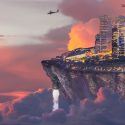You came to a water park for some good old summer fun. But the guy in line in front of you is missing a tooth. And the group behind you seems to be drunk. Now it’s your turn to jump, and you realize you should be wearing a helmet. Broken bones. Missing teeth. Dislocations. This place caused all of them. Action Park, also known as “Class Action Park” or “Traction Park” was a reckless mixture of fun and pain. This dangerous amusement park, located in New Jersey, had its heyday during a carefree period in the 80s. Featuring untested rides, inexperienced staff and alcohol, the number of injuries every year was scandalous. Some of the guests were not aware of the danger, but others were looking for it. Their bruises became their “medals”. How many people died in this amusement park? Which ride had human teeth stuck in it? And why was one attraction known as “The Grave Pool”? You can say that again. Amazingly, Action Park operated from 1978 to 1995. In just one summer, 1986, people reported 330 injuries. These are the park’s most dangerous rides and how to survive them.
Number 5. Cannonball Loop
As we showed you in How to Survive the Most Dangerous Waterslides, this ride could beat you up in only a few seconds. People slid down an enclosed tube that ended in a loop before exiting into a shallow pond. The first dummies they used to try the cannonball loop came missing limbs and their heads. The park had to pay its employees $100 each to test this waterslide. Let’s hope that was enough to pay their healthcare bill. Many of the test riders suffered bloody mouths and noses. Other testers got weird lacerations. Some of the previous riders’ teeth got stuck in the tube, cutting the skin of the few adventurous riders who dared sliding down after them. One way to survive this ride with only minor injuries was making sure you were the right size. People who were too big got stuck. And if you were too lightweight, you wouldn’t get enough momentum to complete the loop.
Number 4. Cannonball Falls
This waterslide got completely dark before ending in a 3 m (10 ft) fall into an icy cold pool. People who rode it for the first time felt panic when they exited the tube and did not see water. Most riders were in shock when they hit the cold water and had to be rescued. Many people didn’t land in the right position and got hurt. To survive this ride, it was important to know how it ended so you didn’t get caught off guard. It was crucial to keep your body loose. Body tension made it more likely you’d break or pull something. And you needed to move out of the way quickly before someone landed on top of you.
Number 3. Man in the Ball in the Ball
In this ride, a person got strapped in the center of a giant ball. It was inside another ball covered in caster wheels. The ball supposedly went downhill on a PVC pipe track. The park gave an employee named Frank $100 to try it. It was a hot summer day, and the heat had melted the glue and expanded the PVC pipes. The ball went off the track, rolled down a 180 m (600 ft) mountain, crossed a freeway and ended up in a swamp. Frank survived. And luckily, this ride was never opened to the public. The lesson here is, if it looks cheap, don’t ride it.
Number 2. Aqua Skoot
Thrill-seekers used a plastic sled to go down a slide made of rolling tubes, similar to warehouse rollers. When you landed on the water, the goal was to skid across the water as long as possible. Many riders leaned forward on their sleds, and they often ended up face-planting into the shallow pool. The ones who didn’t hit their faces and made it across the pool had to deal with another problem. A bees’ nest was waiting for them at the end of the pool, and many guests got stung. On rides like this, lean as far back as possible so you don’t hit the water at a painful angle.
Number 1. Tidal Wave Pool
Six people lost their lives at Action Park. In 1980, 19-year-old George Larsson’s sled ran off the track on The Alpine Slide. He hit his head against a rock and died a week later. Electrocution on The Kayak Experience killed 27-year-old Jeffrey Nathan in 1982. And in 1984, a person suffered a heart attack after falling into the cold water in The Tarzan Swing. The other three deaths happened in Tidal Wave Pool between 1982 and 1987. This pool went from a shallow end to 5 m (16 ft) deep at an almost 45 degree angle, and waves were up to 1 m (3.3 ft) high. The pool contained freshwater, so guests didn’t float like they would in the ocean. It required 12 lifeguards on duty. On busy days, they saved an average of 30 people. The mix of sunscreen, body fluids and dirt made it hard for lifeguards to spot drowning people. The Tidal Wave pool was notoriously dangerous and nicknamed “The Grave Pool” after people died in it. Don’t get into a wave pool if it is too full. And use the safety rope or a ladder if the waves are dragging you underwater. Don’t go to amusement parks alone. Go with friends or family, and help each other if an emergency happens. These days, such a dangerous park wouldn’t be allowed to stay open for more than a summer.But even with better software to design and calculate rides, accidents still happen in many water parks worldwide.
Sources
- ‘People Were Bleeding All Over’: America’s Most Dangerous Amusement Park. Barron, J. (2019). New York Times.
- 8 Terrifying Action Park Deaths and Injuries. Budowski, J. (2020). Decider.
- The Rise and Fall of Action Park, New Jersey’s Most Dangerous Water Park. Holland, B. (2020). History.
- ‘Action Park’ looks back at one very dangerous amusement park. Rosenblit, R. (2020). Washington Post.
- My childhood summers at Action Park, America’s most notorious amusement park. Stump, S. (2020). Today.

















